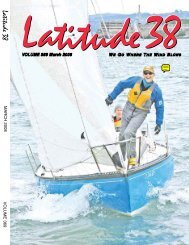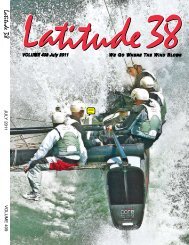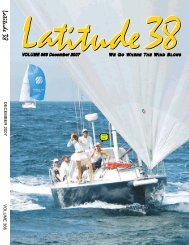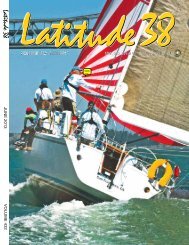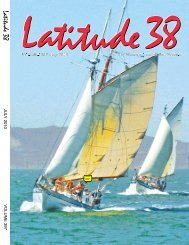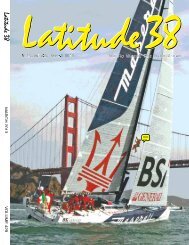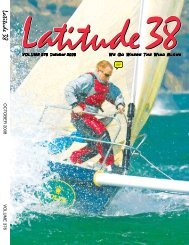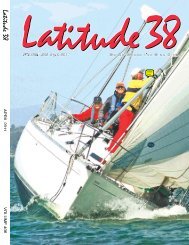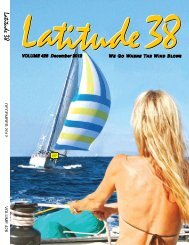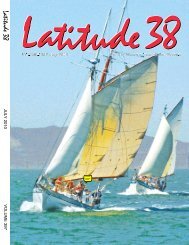October 2009 eBook all pages (free PDF, 36.6 - Latitude 38
October 2009 eBook all pages (free PDF, 36.6 - Latitude 38
October 2009 eBook all pages (free PDF, 36.6 - Latitude 38
You also want an ePaper? Increase the reach of your titles
YUMPU automatically turns print PDFs into web optimized ePapers that Google loves.
License #0E327<strong>38</strong><br />
TWIN RIVERS<br />
MARINE INSURANCE<br />
AgENCy, INC.<br />
“Your Boat Insurance Specialists”<br />
7 Marina Plaza • Antioch, CA 94509<br />
At The Antioch Marina<br />
Need Mexico Insurance?<br />
C<strong>all</strong> Today!<br />
• Mexican Liability • Broad Navigational Areas<br />
• Shop Your Renewal & $ave ~<br />
Flexible Survey Requirements<br />
• Liveaboards • Agreed Value Policies<br />
Get a quick quote today at:<br />
www.BoatInsuranceOnly.com<br />
(800) 259-5701<br />
Insurance made simple, affordable and effective.<br />
Representing…<br />
Page 62 • <strong>Latitude</strong> <strong>38</strong> • <strong>October</strong>, <strong>2009</strong><br />
LLoyd’s<br />
Years of unbeatable experience to<br />
match your needs to the right product.<br />
Worldwide Coverage<br />
West Coast ¤ Mexico ¤ East Coast<br />
Caribbean ¤ Pacific ¤ Atlantic<br />
LETTERS<br />
Brian — For reasons we prefer not to go into, we have what<br />
we c<strong>all</strong> a 'Flintstones System', so named because it's about<br />
as sophisticated as everything was on that cartoon show. For<br />
better or worse, our daggerboards are limited to two positions:<br />
<strong>all</strong> the way up or <strong>all</strong> the way down. As it turns out, the only<br />
time we have the boards down is when we are beating or close<br />
reaching.<br />
Our daggerboards are 14 feet long. Even though they are<br />
heavy, they have a certain amount of positive buoyancy. If not<br />
secured in the up or down position, the top nine feet float in the<br />
daggerboard case. When we want a board in the up position, it<br />
gets held in place — as you suggested — by a 1.5-inch dowel<br />
that runs athwartships at the deck level. It sounds stupid and<br />
looks a little silly, but it's worked out well. The dowel broke the<br />
only time we hit bottom with a daggerboard, <strong>all</strong>owing the daggerboard<br />
to pop up and avoid any damage beyond a scratch.<br />
If we want to put the board in the down position, we have<br />
to lift it slightly to be able to slip the dowel pin out. It's a oneperson<br />
job when we use the electric halyard winch. If we're in<br />
a hurry, two guys muscle the board one quarter inch up, and<br />
another member of the crew pulls the pin. Then we step on<br />
the top of the board to counteract the positive buoyancy and<br />
make it flush with the deck. At that point a person in the head<br />
pushes the pin through a hole in daggerboard case and the<br />
daggerboard, which secures it in the down position. To raise the<br />
board, someone has to step on it just right in order for another<br />
someone in the head to be able to pull the pin out. Once the<br />
board pops <strong>free</strong>, it has to be lifted to the full-up position, either<br />
with a halyard or by hand.<br />
To date we've been happy with our ultra KISS system. Good<br />
luck with your cat and daggerboard system design.<br />
⇑⇓JOLLY ROGER IS WORRIED ABOUT PIRATES<br />
I'll be sailing from Guaymas, Mexico, to the Panama Canal<br />
in November of this year, and expect to take two months to<br />
reach the Canal, including a week or so in Costa Rica. I have<br />
a few questions about my route. First, can you suggest interesting<br />
ports that I should stop at? I have <strong>all</strong> the large ones<br />
plotted, but you may know a few that are sm<strong>all</strong>, inexpensive<br />
and interesting. Second, are there places that I should avoid<br />
because of known piracy or other factors such as very high<br />
mooring or fuel prices?<br />
I'm then going to sail south from the Canal, and was told<br />
to avoid Colombia. What information do you have on ports in<br />
Venezuela and the Lesser Antilles? And last, I will need to put<br />
the boat on the hard out of the hurricane zone, and therefore<br />
need to know of a place south of Venezuela.<br />
By the way, I did the Ha-Ha last year and had a re<strong>all</strong>y fun<br />
experience.<br />
Roger Behnken<br />
Jolly Roger, Bombay 44<br />
Berkeley<br />
Roger — Thanks for the kind words about the Ha-Ha. As<br />
for places to stop between Guaymas and the Canal, they are<br />
<strong>all</strong> pretty well-known, and as you near each place you'll be<br />
getting the most current info and recommendations from fellow<br />
cruisers. Puerto Madero, Mexico, is a place where some cruisers<br />
have had trouble with officials, so keep your ears open once<br />
you get in that area. Lots of cruisers rush past the islands off<br />
the north coast of Panama, but those who stop seem to re<strong>all</strong>y<br />
enjoy them. But you may be in too much of a hurry to do that.<br />
Berthing and moorings in Third World countries tend to be at<br />
least as expensive as in the States, so if you're on a budget,<br />
ask around for the best places to anchor. There are plenty. As



